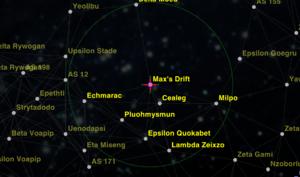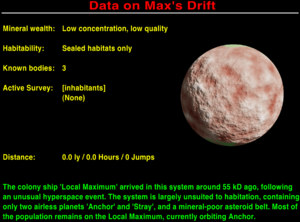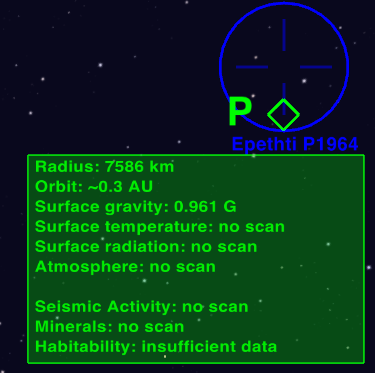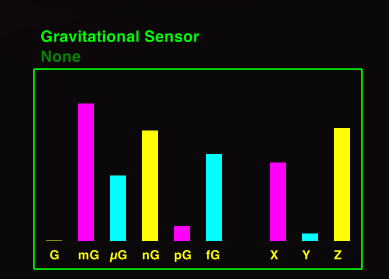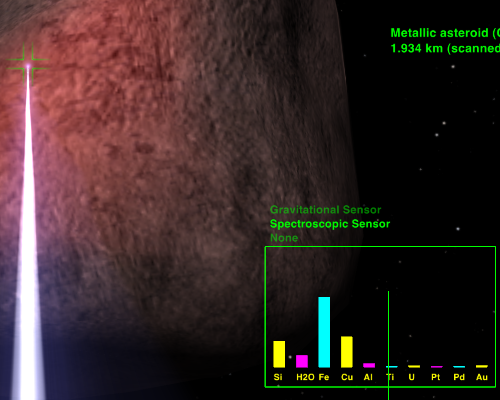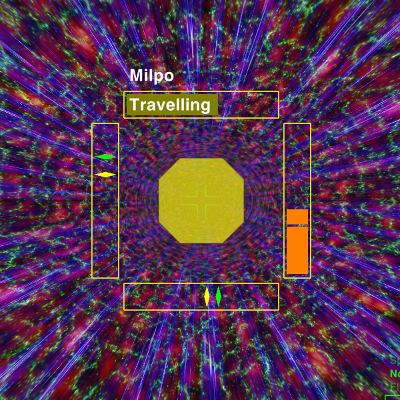Difference between revisions of "SOTL Exploration"
Cholmondely (talk | contribs) (Removed misleading references to nightly builds, better links, tweaks, screen shots) |
Cholmondely (talk | contribs) m (Tagged as demo-OXP) |
||
| (One intermediate revision by the same user not shown) | |||
| Line 105: | Line 105: | ||
*[[User:Cim|Cim]]: link to author's page & his other oxp's |
*[[User:Cim|Cim]]: link to author's page & his other oxp's |
||
| − | [[Category:Misc OXPs]] |
||
| + | {{Unclassified-OXP}} |
||
| + | {{demo-OXP}} |
||
Latest revision as of 00:17, 16 December 2021
Song of the Labyrinth: Exploration is an experimental scenario OXP for Oolite, set in a very different part of space, and a considerably lower-tech environment than the Oolite setting.
Contents
Overview
The colony ship Local Maximum suffered an extremely severe hyperspace misjump around seventy years ago, arriving in an uncharted system thousands of light years away from known space. The colony ship's hyperdrive was severely damaged, and the dim red star they named Max's Drift had no habitable planets and poor mineral reserves. Most of the ship's internal equipment survived the accident, and the colonists have been able to survive using hydroponics facilities and extracting water and metals from the system's asteroids.
Mining has recently obtained a small surplus of Uranium and Osmium required for the production of hyperspace fuel, and a cargo shuttle has been extensively refitted to carry a small hyperdrive and a range of survey gear. Its initial task is to survey the local cluster, hoping to find minerals which so far have not been located in exploitable quantities, both to restock the colonists' reserves and to allow fuel and equipment to be produced for a more extended mission.
Download
There are 3 files.
- The Exploration OXZ (0.4)
- The Loader OXZ (1.1)
- And Altmap (1.0) - see SOTL Altmap for details of this second scenario
As this is a scenario OXP which changes many of Oolite's basic rules, it is disabled in conventional Oolite games, and requires the starting of a new game from a special position to play it. This position is available in the SOTL Loader/Startup OXP (for technical reasons this must be downloaded separately).
None of your normal OXPs will be usable in a SOTL Exploration game.
For more information, see the forum thread
Warning
This is currently an experimental OXP, and the Startup OXP may need to be updated sometimes when the main OXP is - which will mean you lose any progress (and of course, you also have to use a nightly Oolite build). Comments during development are extremely welcome but don't get too attached to your progress yet.
Equipment fitting
The Shaula-class survey ship you fly can carry ten modules (in addition to the generator and flight computer which must be carried). The initial fitting is 3 fuel tanks, 3 capacitors, 1 gravity sensor, 1 spectroscopic sensor, and 1 prospecting laser, though you can customise this as much as you like before you leave.
Flight computer
The flight computer provides navigation support in both normal space and hyperspace, and integrates the output from your ships sensors - without it, you will have to carry out many more tasks manually, and you are recommended to return to base immediately for repairs.
It will automatically mark planets once you approach closely enough to get accurate information on their position and speed, and give them a preliminary designation. Information about the currently selected target will be displayed on your HUD
It has three primable modes:
- bookmark: place a waypoint at your current location and heading. Useful if you spot something interesting but can't immediately check it out. Only one bookmark can be used at once.
- lagrange: places a waypoint at each of the 5 Lagrange points of the currently selected planet. Both the planet and star must have mass estimates recorded for this to work. The L4 and L5 points are stable and may contain small clusters of asteroids.
- engine mode: switches the engines between "precision" and "cruise" mode. Cruise mode is significantly faster and will generally be used, but precision mode will make flying near asteroids and docking with the Local Maximum considerably safer. You must be stationary to switch engine modes.
Fuel tanks
Fuel tanks carry hyperspace fuel. Each tank carries 6 tonnes of fuel. A hyperspace jump consumes fuel in tonnes equal to the square root of its distance in LY (i.e. longer jumps are more fuel-efficient). Exiting a jump early will not save fuel. The only current source of fuel is the Local Maximum - plan your jumps carefully or risk being stranded in another system forever.
Capacitors
Capacitors store energy from your generator to provide boosts to particular energy-intensive systems such as the lasers and hyperdrive. The more you have, the more margin for error you have in carrying out tasks, and the longer hyperspace jumps you can safely carry out.
Gravity scanner
The gravity scanner allows the mass of nearby stars and planets to be estimated. If multiple are fitted, they are used in parallel to provide more accurate readings. You must be at a complete stop to use it. You may turn with it in use, but this will interfere with the readings.
Use the mode key ('b') to cycle between the four modes of operation, and press 'n' to activate the current mode:
- power on/off: initial mode, you must switch it off to re-engage drives
- scan on/off: while scanning, it will collect gravitational data, giving you the intensity and direction of the net gravitation force (in the screenshot, below and slightly ahead of the ship). The longer the scan runs for, the more precise a reading you'll get. You can turn the ship while the scan is running, but this will affect the data quality and you'll then need to wait a little bit for it to settle. Once you're happy with the data collected, press 'n' to stop the scan
- assign scan: assigns the scan data to the selected compass target (you need to pick for yourself what object you believe to be the gravitationally dominant one). The system will filter out components of the gravitational force not parallel to the direction of the target, and then use that to calculate surface gravity
- filter scan: if you already know the approximate mass of an object from a previous scan, you can filter it out of the scan by selecting it with the compass and pressing 'n' in this mode. This lets you get more accurate readings for unmeasured objects, and with sufficient practice and luck can also help you find undiscovered planets.
Spectroscopic scanner and prospecting laser
The spectroscopic scanner lets you determine the composition of stars, planets and asteroids by measuring emitted or reflected light. It returns the relative amounts of ten elements or compounds of particular survey interest, on a logarithmic scale.
To use it, point your ship at the thing you want to scan, target it with compass or ident as appropriate, activate the sensor with 'n', and cycle the mode to the correct scan (star, planet or asteroid) with 'b'. Then, activate the scan with 'n' and watch the composition bars climb.
If the target is an asteroid, you'll need to fire the prospecting laser to get anything decent out of the scan.
When the scan looks done, press 'n' again to stop the scan and assign the results to the targeted body. Stars and planets are targeted with the compass; asteroids with the ident system.
Try to stop the scan when the highest of the ten bars reaches the top but no later. Stop too soon and you'll not have collected enough light and may miss some important trace components or have inaccuracies in parameters; stop too late and you'll oversaturate the sensors and corrupt the result.
The bars will go up faster the closer you are to the object, which reduces measurement noise - as does fitting multiple units - though this must be balanced against the risk of oversaturation.
You get different information depending on what you targeted
- Stars: brightness, and metallicity. Metallicity gives you a very rough idea of how likely the system is to be dense in heavy elements, based on the traces of them in the corona.
- Planets: surface temperature and atmosphere type
- Asteroids: mineral composition (there are a lot of potential minerals, so there's two scan types). Any minerals detected in exploitable amounts will be noted on scan completion - the threshold is a lot lower for the rare ones.
Sampling laser and sample collection bay
The sampling laser will break small chunks off an asteroid - ideally one you have previously scanned with the prospecting laser - which can then be scooped into the sample collection bay and returned to the Local Maximum for extraction of valuable minerals. Each collection bay will hold 15 samples. (On particularly mineral-rich asteroids, a single sample may contain multiple usable minerals)
Hyperspace
Hyperspace travel is dangerous - especially in a ship as improvised as the Shaula-class. When you activate the hyperdrive, an additional instrument display will be projected on to your HUD
- Above: progress to destination. This starts with you leaving the gravitational influence of your current system, then travelling through hyperspace, then entering your destination system. If you need to drop out mid-jump, this will determine where you end up.
- Right: current energy reserves. Hyperspace travel is energy-intensive. If you run out of energy mid-jump, your ship will be destroyed as it fails to maintain hyperspatial integrity. You can press 'h' again to abort the jump and drop out away from your destination, which will damage your ship due to the rough exit, but you should at least survive.
- Centre: jump status. If this is yellow or green the jump is going well. If orange, you are losing energy fast but should have sufficient reserves to finish the jump. If red, you do not have sufficient reserves at the current rate of energy loss to complete the jump (this will start flashing red/black if you have fewer than 5 seconds available)
- Left, bottom: jump alignment. You need to handle a lot of the jump yourself. Keep the yellow marks aligned with the green ones using your pitch and roll controls - the closer the alignment, the less energy you will need to maintain hyperspatial integrity.
The pattern you need to align to is a property of the particular jump you are making, so with practice you can use less energy. Additionally, the more times you complete a jump the more computer assistance you receive with future jumps on the same route, which reduces the precision needed to maintain energy levels. (This means you need to carry fewer energy banks and can carry more survey equipment instead)
Jumps are non-linear: - time aligning in hyperspace needed to complete the jump is proportional to distance - real time taken is proportional to distance squared - fuel usage is proportional to the square root of the distance
As large masses travel through normal space, they leave ripples behind them in the hyperspace medium, and semi-stable calm points. The larger the mass, the better the calm point. For this reason, a successful jump will place you in the calm point for the system's star.
Version History
See the BB Discussion thread for Cim's 2021 notes about what he had hoped to add.
- 0.4: added sampling laser and collection bay, adjusted HUD to be easier to read when facing star
- 0.3: added spectroscopic scanner, asteroids, prospecting laser
- 0.2: first public release, added gravity scanner, stars, planets
- 0.1: unreleased, hyperspace changes only
Links
- SOTL Altmap - for details of the second game!
- BB Discussion Thread (2015+)
- Cim: link to author's page & his other oxp's
